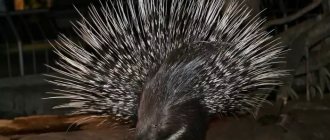- Wild animals
- >>
- Mammals
Not everyone knows such a small exotic animal as tupaya . Many people hear the name of this unusual animal for the first time. When looking at tupaya, some compare it to a squirrel, others to a rat. Undoubtedly, one thing is that it is a very active and nimble creature. Let's try to understand his lifestyle, describe external signs, characterize his character, food preferences and places of permanent residence.
Origin of the species and description
Photo: Tupaia
Tupaya is a mammal belonging to the family of the same name and the order Tupai. Confusion regarding whether tupaya belonged to one or another class of animals lasted for decades. At first, tupaya was classified as an insectivorous animal, then as a primate. For half a century, this mammal was classified as a primate until new detailed studies were carried out. As a result, it turned out that the tupaya is a separate evolutionary branch that has characteristics characteristic only of this species, so the animal was assigned to the order Tupaya or Scandentia.
Documentary mention of the tupai was recorded in 1780 by Dr. William Ellis, who accompanied Cook on a trip to the Malay Archipelago. The name of the animal comes from the Malay language, or more precisely from the specific word “tupei”, which translates as “squirrel”. The tupai family is divided into two subfamilies, 6 genera and 18 varieties. Scientists have studied the common tupaya in more detail, the appearance of which we will describe a little later, and now we will characterize other species of these mammals.
Video: Tupaia
The large tupaya has a grayish-brown color, the length of its body reaches 20 cm, and the tail of a golden-red hue is the same length. The animal settled on the Malaysian islands (Sumatra, Kalimantan, Borneo). This tupaya is distinguished by large rounded ears, a sharp face and deep, expressive eyes.
The Malayan tupaya can reach from 12 to 18 cm in length, including the tail. Against the overall dark brown background of the animal, the lighter yellowish abdomen is clearly visible, the whole body is quite graceful and sophisticated. The animal has chosen Thailand and the Indonesian islands. Malay representatives of the Tupaidae are monogamous and form a family union for life.
The Indian tupaya is similar to the ordinary one; its muzzle is also shortened. The difference is noticeable in the ears, covered with hair; it is also distinguished by the structure of the teeth. The predominant background of the ridge is brown with red, yellowish and black inclusions. Light stripes are visible on the shoulders. The length of the animal’s body is about 20 cm, the tail has the same length. Tupaya lives on the Hindustan Peninsula in its northern part.
The feather-tailed tupaya is poorly studied; it is distinguished by its small size (length 10 cm), impressive and pointed ears and nocturnal lifestyle. Its main feature is the tail, covered with dark scales with a rare white tassel at the end. The animal's fur is gray with brownish and black patches. The tail length varies from 11 to 16 cm, these tupai live in Sumatra and the Malay Peninsula.
The smooth-tailed tupaya is considered a rare species native to Borneo. Dark stripes with a reddish tint are visible on its face, the animal’s spine is almost black, and the abdominal area is light. The Philippine Tupaia has bright brown fur on the back, while the belly and chest are a lighter shade. The body length is 20 cm, and the weight is about 350 grams. The animal is distinguished by a short tail.
Classification and taxonomic history[edit]
When DiarD and Duvaucel described the first specimen in the common Blunt Tapaia Glis
in 1820, they considered it to be a variety of
Sorex.
[6]
T. everetti
was returned to the genus from
Urogale
, dissolving the latter based on a 2011 molecular phylogeny. [7]
of Tupaia were described
: [1]
- Northern stand of T. belangeri
- Wagner, 1841 [8] - Golden-bellied sapling T. chrysogaster
- Miller in 1903 [9] - Striped shrew T. dorsalis
- Schlegel in 1857 [10] - T. everetti
was grown in Mindanao by Thomas in 1892 [11] - Slender tree of T. gracilis
- Thomas in 1893 [12] - Horsfield wood bushes T. javanica
- Horsfield in 1821[4][13] - Long-legged two-tooth T. longipes
- Thomas in 1893 [14] - Dwarf tree T. minor
- Gunter in 1876 [15] - Kalam tree T. möllendorffi
- Matches in 1898 [16] - Mountain tree T. montana
- Thomas in 1892 [11] - Nicobar tree shoot T. nicobarica
- Zelebor in 1868 [17] - Palawan thicket of T. palawanensis
- Thomas in 1894 [18] - Painting of a T. picta
by Thomas in 1892 [11] - Rufous bush T. splendidula
- Gray in 1865 [19] - Large stand of T. tana
- Raffles in 1821 [2] - † Tupaia miocenica
- Main and Ginzburg in 1997 [20]
In the past, various authors have proposed placing shrews under the order number Insectivora or considering them to be closely related to primates. Since 1972, the tree families Tupaiidae and Ptilocercidae have been grouped into the order Scandentia. [21] [22] [23]
Appearance and features
Photo: Common tupaya
We will describe the characteristic features of the animal and its distinctive external features using the example of the common tupaya, which has been most studied by zoologists. This is a small animal that looks like a squirrel. The length of the tupaya's body ranges from 15 to 22 cm, the weight of the animal varies from 140 to 260 grams.
Interesting fact: Zoologists have noticed that the further south the common tupaya lives, the lighter the color of its coat.
The muzzle of the tupaya is elongated and pointed. The animal's eyes are medium in size and dark in color. Short and thin vibrissae are noticeable on the sharp face. The ears of the tupaya are neat and rounded. Compared to other species of these animals, the common tupaya has less thick fur. The dorsal part of the animal has a dark brown color scheme, and in the chest and abdomen the color is lighter, reddish. On the shoulders you can see lighter, but very faded stripes.
As for the obvious differences between a male and a female, there are practically none, so only a competent specialist can distinguish the sex of an animal purely visually. Tupaia's paws are five-fingered, each finger is equipped with a fairly long and sharp claw, which helps when moving in the crown of trees. The structure of the teeth of tupaya is similar to insectivorous mammals. Also, in the throat area there is a skin gland, the presence of which is characteristic of some insectivores. It should be noted that a female can have from one to three pairs of nipples. In general, scientists identify about 49 subspecies of the common tupaya.
Relationships with people
As game animals, tupai are completely uninteresting - their fur is not valued on the market, and the meat is not very pleasant to the taste. In pursuit of tasty treats, animals often enter homes, gardens and farmland, eating whatever they find. But there are not many losses from them, and no one specifically shoots them.
They are not very common as pets, but keeping them in captivity is quite possible. To do this, you definitely need a spacious enclosure with a volume of at least 1.3 m3. It will have to be equipped with various branches and secluded corners, as well as a place that will pass as a nest for the animal. It is better to keep tupai in pairs, and if offspring appear, you will have to acquire a second nest, because the children of these animals always sleep in a separate “room”.
Where does the tupaya live?
Photo: Tupaya animal
In general, the tupai family is quite exotic; its representatives inhabit humid tropical forests in southeast Asia. As noted, different species occupy different regions and landscapes. The common tupaya is registered on the Indonesian islands, China, northern India, and its range covers both the southern and eastern parts of Asia.
Tupaya has taken root well on various islands of the Malay archipelago, among which are:
- Java;
- Sumatra;
- Riau;
- Kalimantan;
- Lingu;
- Anambas;
- Borneo.
Tupayas have become popular in the areas of Thailand, Singapore, the Philippines, and the Indian subcontinent. Animals love and feel great in humid, tropical, and forest areas. Tupai live both in the crown of trees and on the ground. The animals also do not shy away from mountainous areas, meeting at altitudes of two to three kilometers. Tupai make their lairs in the hollows of fallen trees, between powerful tree roots, and in bamboo cavities. Each animal has its own separate allotment.
If we talk about the common tupaya, the vastness of its range can be imagined by the area it occupies, which is more than 273,000 square kilometers. The population density of animals can vary from 2 to 12 animals per hectare.
Interesting fact: Tupai do not shy away from people at all and often live next door to them, settling on cultivated plantations where there is plenty of food.
LIFESTYLE
Common tupai live in tropical rainforests. In its homeland, this small animal conducts a continuous search for food throughout almost the entire day. Most often it feeds on the ground, sometimes in trees. On the ground, the common tupaya searches for beetles and other insects in fallen leaves. During daylight hours, tupaya is highly mobile. These animals live in pairs or small herds. Adults mark their territory with urine and secretions from scent glands. Noisy fights occur from time to time at the borders of territories between the owners of various plots. Tupai make their nests in tree hollows. Tupai move in quick jumps, constantly stopping, sitting down and looking around - checking that there is no danger. In case of danger, to distract the attention of a predator, the tupaya waves its tail, which is the same length as its body, and at the same time squeaks loudly and shrilly. She tries to hide in the nest as quickly as possible or find refuge on the ground.
What does tupaya eat?
Photo: Tupaia in nature
The tupaya's diet consists of various fruits and insects, but sometimes these animals can also snack on small vertebrates (mice, chicks, lizards). Tupaia eat various seeds, grains and berries. During the meal, the animals hold their food with their tenacious front paws. The animals' reaction is very well developed, so they can catch insects on the fly with the help of their forelimbs.
The search for larvae, all kinds of bugs, and ants is usually carried out on the surface of the earth in fallen leaves or in cracks in tree bark. The surface of the tupaya teeth can be compared to a grater, which easily grinds the hard peel of various fruits or the chitinous shells of insects. Tupai seek out their prey with the help of excellent eyesight and a keen sense of smell; it is not for nothing that the animal’s nostrils are similar to those of a dog.
Tupai, settling on cultivated plantations, damage the crop by eating ripe fruits and berries. Sometimes these animals carry out predatory raids on bird nests, from where they can steal eggs and newborn chicks. In search of food, tupai twitch their long tail and interestingly move their elongated nose, sniffing out a snack. Tupai love to eat nuts and palm sap.
Interesting fact: Clever and thieving tupai were seen in predatory raids on human homes, from where they stole food, entering houses through open windows and vents.
Now you know what to feed tupaya. Let's see how the animal lives in the wild.
Features of character and lifestyle
Photo: Tupaya animal
Most members of the tupai family are active during the day. The animals spend approximately equal periods of time both in the tree crown and on the surface of the ground, where they carefully rummage through dry foliage, looking for something tasty. At night, the animals rest in their shelters. Each mature animal has at its disposal its own plot of land, which is jealously and tirelessly guarded.
If it is difficult to distinguish a male from a female in appearance, then by the size of the area you can immediately understand who it belongs to. Males have more extensive land areas than females. Property boundaries are marked using scent glands, feces and urine.
Interesting fact: The specific aroma of the marks is so concentrated and strong that it does not disappear immediately, remaining for several days. After this period, the tags are updated.
Having noticed a stranger on their territory, tupai immediately begin to aggression, so fights and all kinds of skirmishes often occur between them.
The animals talk to each other using various sound signals that resemble:
- squeak;
- scream;
- clicking;
- whistling;
- twitter.
When an animal is aggressive, it makes a characteristic squeal. Although the tupai are small, they are very scary when angry, so in a fierce fight one of the opponents may die, which often happens.
Scientists are very interested in the tupaya feathertail's addiction to drinking fermented palm sap, which contains alcohol. The indigenous population knows about this property of the drink and uses it successfully, just like the tupai, but the effect of intoxication in the animals was not noticed, their coordination does not suffer from the drink, which is simply surprising.
Interesting fact: In the feather-tailed tupaya, alcohol in the body is broken down in a different way from humans, so even large doses of palm nectar drunk do not trigger the process of intoxication of animals.
Medical research[edit]
Their close relationship to primates makes them important model organisms in human medical research. A study examining the effects of the Borna disease virus on earthen fungi has provided new insights into neurological diseases. [32]
Since Tupaia
have much in common with primates, but are more numerous and have more abundant offspring than them, there is increasing interest in their use as an alternative model for use in human medical research.
Successful psychosocial studies have been conducted and dramatic behavioral, neuroendocrine and physiological changes have occurred in subordinate male Tupaia
, similar to depressed patients.
Their susceptibility to viruses has also sparked interest in using them to study the immune response to infections such as hepatitis. [33] Blunt
species have been used to overcome the limitations of using rodent models in the study of human biology and disease mechanisms, and to develop new drugs and diagnostic tools. Recent studies have used pine trees to study infectious, metabolic, neurological and psychiatric diseases, as well as cancer. [34]
In 2013, the Virology Journal published
published a paper documenting the use of northern shrews (
T. belangeri
) as medical models of the H1N1 influenza virus.
This was beneficial because other possible candidates, such as guinea pigs, rats, mice and other rodents, leave gaps in information, especially regarding clinical symptoms and transmission. However, Tupaia
exhibits mild systemic and respiratory symptoms and pathological changes in the respiratory tract, supporting its use as a useful model in H1N1 research. [35]
Social structure and reproduction
Photo: Tupaia from the Red Book
Tupai prefer solitude, but some live in family groups consisting of parents and their offspring; mature young males leave the family, and females often live in their parental home. Animals like to feed one at a time. Tupai become sexually mature at the age of three months. For the most part, these animals are monogamous, creating strong family units.
Interesting fact: Polygamy among tupaiids is inherent in individuals living in the vast expanses of Singapore, where the territory of one male overlaps with the territories of several females at once.
The animals do not have a special wedding period; they are capable of breeding all year round, but they show the greatest zeal in this regard from the beginning of February to June. The female's pregnancy lasts for seven weeks. A litter can consist of one to three cubs, the weight of which does not exceed 10 grams. At birth, babies are completely blind and helpless, they have no fur and their ear canals are closed. At the age of ten days they begin to hear, and begin to see clearly closer to three weeks.
Tupai are not very caring parents, or rather they can be called indifferent towards children. The mother lives separately from the babies, and treats them with her milk only once in two days, allocating only five to ten minutes for feeding, so the poor babies have a hard time. The babies do not leave their nest until they are a month old, then they begin to make active forays, soon move to their parents’ nest, and a little later they gain complete independence, arranging their own lives.
It should be added that common tupai live in natural conditions for only about three years. In favorable conditions of captivity, their life span increases significantly, reaching nine and ten years. There are cases when domesticated tupayas overcame the twelve-year life span.
Distribution and habitat[edit]
Species of Tupaia
range from northeast India, Burma and the Nicobar Islands east to the Philippine Islands and from central southern China to Java, Borneo and Sumatra, including islands on the southwest coast. They are not found on Celebes, nor on the islands east of Java, with the possible exception of Bali. [4]
They live in the dense undergrowth of tropical forests. Except for T. minor
, they are primarily terrestrial and feed on the forest floor, usually less than 1.5 m (4.9 ft) deep. Because they rarely cross wide roads, the population is likely negatively affected by forest fragmentation caused by logging. [24]
Natural enemies of tupaya
Photo: Great Tupaia
The small-sized tupai have many enemies in harsh natural conditions. Animals are attacked by land predators, animals are also attacked from the air, some poisonous snakes pose a great danger. The natural enemies of the tupaya include: various feathered predators, the harza or yellow-breasted marten, snakes especially, the Edged Keffiyeh and the Green Snake.
Of course, inexperienced and therefore highly vulnerable young animals are most at risk. Tupaya is often saved by her nimbleness, dexterity and agility, her ability to perfectly navigate the tree crown and move quickly in it.
People do not purposefully destroy these unusual animals, people do not eat tupaya meat, it is considered inedible, and the animal’s fur is also of no value, therefore, as a hunting object, tupaya is not interesting. If we talk about the harm that animals cause to cultivated plantations, then it can be called insignificant, because of this, people also do not persecute tupaya.
Still, humans can be counted among the enemies of tupaya, because through their vigorous economic activity they have an indirect influence on many animals, including these. By invading places where animals are permanently located, cutting down forests, expanding and building cities, laying new highways, and worsening the environmental situation in general, people are displacing the tupaya from its usual favorable habitats, which negatively affects its life activity.
Tupaia and man
Tupai are very inconspicuous animals, their contacts with humans are limited. Sometimes they penetrate into people's outbuildings and also cause damage on fruit plantations. In turn, they are affected by human activity, especially where it threatens the existence of natural landscapes. Therefore, some rare species of tupai are threatened with extinction due to the disappearance of their habitats.
- Slender-bodied lemurs
- Types of elephants
- Where do scorpions live?
- Dwarf and...
- Little hand (ah-ah)…
- Gibbons: what is it...
Population and species status
Photo: Tupaia vulgare
Such a variety of tupayas as tupaya vulgaris is considered not only the most studied, but also the most numerous. Although its habitat is very limited, the number of this animal remains at the proper level, without experiencing sharp jumps in the direction of decline or increase in the number, but there are minor gradual shifts aimed at reducing the number of these animals. The density of common tupaya in different habitats varies from 2 to 12 individuals per hectare area.
Indian tupaya cannot be called numerous, because. It is endemic to India, its distribution area is too limited. Smooth-tailed tupai living in the north of the island of Borneo are considered a rather rare species of these animals; their population size is small. Most tupaiids can be called poorly studied, so there is no clear information regarding the size of their populations.
Interesting fact: The tail of the common tupaya is comparable in length to the length of its body, and sometimes can even slightly exceed it.
If we talk about the Tupai family as a whole, the number of its representatives is gradually decreasing. This happens as a result of human impact on the environment; people destroy the places of permanent residence of animals, which leads to their death, and, consequently, increases the risk of extinction of the species. Some varieties of tupaya cause concern among environmental organizations.
Who is Tupaya
This animal has long been a mystery to scientists: it is very difficult to classify it. Zoologists could not decide where to classify tupaya: rodents or primates. As a result, they created a separate squad called Scandentia.
What are the difficulties of classification? It's all about their morphology, their way of existence. The appearance of the tupaya is similar to a rat squirrel with the makings of a lemur. In terms of size, the animal can be confused with a chipmunk. And it eats anything, but most often eats fruits and insects. There are ears and a tail, like rodents. 38 teeth!











